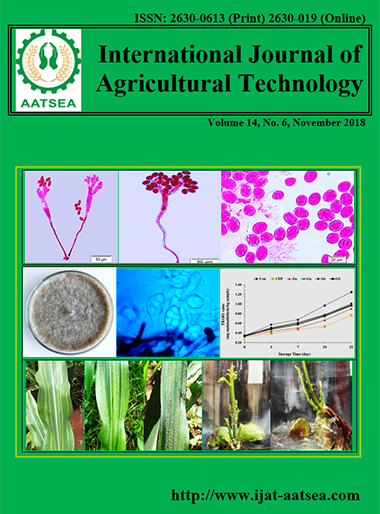The Roles of Calcium Lactate on Bruised Damage in Papaya Fruit
Main Article Content
Abstract
Bruise damage reduces postharvest quality and it was rejected by consumer. Lack detail about bruise mechanism reported in papaya fruit, the prevention and reduction of postharvest loss were limited. The tissue softening as a result in the change of cell wall solubility and depolymerization including changes in physical properties were following bruise damaged. The maintaining cell wall integrity by calcium lactate application before bruising was tested. Papaya fruits were non-dipped or dipped in 2% calcium lactate solution at 55°C for 5 minutes, then air dried at room temperature for 1 hour. Two groups of fruit sample were separated; one group was impacted from height level at 75 cm while the other was non-impacted. The result showed that bruise treatment reduced skin lightness, chroma and hue angle especially in ‘Khak dam’ papaya, but could maintain by calcium lactate application. This treatment also preserved the reduction of fruit firmness by 4 days concomitant with the solubilization of pectin during bruising was reduced by calcium lactate treatment. Water-, Na2CO3 - and potassium hydroxide-soluble fraction were low in calcium lactate treatment both with and without bruise damage. Non-significant different between non-dipped and dipped in calcium lactate in TSS, skin color development and fresh weight loss in bruise treatment. However, calcium lactate treatment reduced the increase in bruise area of 20 and 10% in ‘Khak dam’ and ‘Holland’ papaya, respectively. Fruit decay incidence was 5% low in fruit treated with calcium lactate following bruise damage than non-dipped.
Article Details

This work is licensed under a Creative Commons Attribution-NonCommercial-NoDerivatives 4.0 International License.
References
Alandes, L., Hernado, I., Quiiles, A., Perez-Muauera, I. and Luach, M. A. (2006). Cell wall stability of fresh-cut Fuji apples treated with calcium lactate. Journal of Food Science. 71:615-620.
Ahmadi, E., Ghassemzadeh, H.R., Sadeghi, M., Moghaddam, M. and Neshat, S. Z. (2010). The effect of impact and fruit properties on the bruising of peach. Journal of Food Engineering. 97:110-117.
Alandes, L., Hernando, I., Quiles, A., Pérez-Munuera, I., Lluch, M. A. (2006). Cell wall stability of fresh-cut Fuji apples treated with calcium lactate. J. Food Sci. 71: 615-620.
Blahovee, J. and Paprstein, F. (2005). Susceptibility of pear varieties to bruising. Postharvest Biology and Technology. 38:231-238.
Chardonnet, C. O., Charron, C. S., Sams, C. E. and Conway, W. S. (2003). Chemical changes in the cortical tissue and cell walls of calcium infiltrated ‘Golden Delicious’ apples during storage. Postharvest Biology and Technology. 28:97-111.
Chung, T.T., West, G. and Tucker, G. A. (2006). Effect of wounding on cell wall hydrolase activity in tomato fruit. Postharvest Biology and Technology. 40:250-255.
Blumenkrantz, N. and Asboe-Hansen, G. (1973). New method for quantitative determination of uronic acids. Analytical Biochemistry. 54:484-489.
Garcia, J.L., Ruiz-Altisen, M. and Barreiro, P. (1995). Factors influencing mechanical properties and bruise susceptibility of apples and pears. Journal of Agrictulture and Engineering Research. 61:11-18.
Garcia, J. M., Gutierrez, F., Castellano, J. M., Perdiguero, S. and Albi, M. A. (1996). Influence of storage temperature on fruit ripening and olive oil quality. Journal of Agricultural and Food Chemistry. 44:264-267.
Goulao, L. F. and Oliveira, C. M. (2008). Cell wall modifications during fruit ripening: when a fruit is not the fruit. Trends in Food Science and Technology. 19:4-25.
Hadfield, K. A. and Bennett, A. B. (1998). Polygalacturonases: many genes in search of a function. Plant Physiology. 117:337-343.
Huber, D. J., Karakurt, Y. and Jeong, J. (2001). Pectin degradation in ripening and wounded fruits. Brazilian Journal of Plant Physiology. 13:224-241.
Khurnpoon, L. and Siriphanich, J. (2012). Change in fruit quality and cell wall polysaccharides in bruised papaya cultivar ‘Khak Dum’ and ‘Holland’. Acta Horticulturae. 945:381-389.
Luna-Guzman, I. and Barette, D. M. (2000). Comparison of calcium chloride and calcium lactate effectiveness in maintaining shelf stability and quality of fresh-cut cantaloupe. Postharvest Biology and Technology. 19:61-72.
Martin-Diana, A. B., Rico, D., Firas, J. M., Henechan, G. T. M., Mulcahy, J., Barat, J. M. and Barry-Ryan, C. (2006). Effect of calcium lactate and heat-shock on texture in fresh-cut lettuce during storage. Postharvest Biology and Technology. 77:1069-1077.
Mignani, I., Greve, L.C., Ben-Arie, R., Stotz, H.U., Li, C., Shakel, K. and Labavitch, J. (1995). The effect of GA, and divalent cations on aspects of pectin metabolism and tissue softening in ripening tomato pericarp. Physiology of Plant. 93:108-115.
Mitsuhashi‐Gonzalez, K., Pitts, M. J., Fellman, J. K., Curry, E. A. and Clary, C. D. (2010). Bruising profile of fresh apples associated with tissue type and structure. Applied Engineering in Agriculture. 26:509‐517.
Monsalve-Gonzalez, A., Barbosa-Canovas, G. V. and Cavalieri, R. P. (1993). Mass transfer and textural changes during processing of apples by combined methods. Journal of Food Science. 58:1118-1124.
Morris, J. R., Sistrunk, W. A., Sims, C. A. and Main, G. L. (1985). Effect of cultivar, postharvest storage, preprocessing dip treatment and style of pack on the processing quality of strawberries. Journal of American Society for Horticultural Science. 110:172-177.
Rehman, A. U., Ali1, A., Khan1, A., Qayum, A., Rahman, Z., Waqas, H., and Rehman, Z. U. (2017). Effect of calcium lactate concentrations on post-harvest storage life of apple fruit. Pure and Applied Biology. 6:1340-1344.
Rico, D., Martin-Diana, A. B., Firas, J. M., Barat, J. M., Henechan, G. T. M. and Barry-Ryan, C. (2007). Improvement in texture using calcium lactate and heat-shock treatments for stored ready-to-eat carrots. Journal of Food Engineering. 79:1196-1206.
Van linden, V., Sila, D. N., Duvetter, T., De Baerdemaeker, J. and Hendrickx, M. (2008). Effect of mechanical impact-bruising on polygalacturonase and pectinmethylesterase activity and pectic cell wall components in tomato fruit. Postharvest Biology and Technology. 47:97-106.
White, P. J. and Broadley, M. R. (2003). Calcium in plants. Annals of Botany. 92:487-511.


